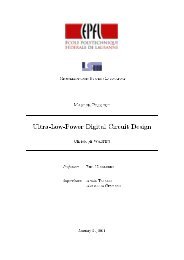Compressive Sensing system for recording of ECoG signals in-vivo
Compressive Sensing system for recording of ECoG signals in-vivo
Compressive Sensing system for recording of ECoG signals in-vivo
Create successful ePaper yourself
Turn your PDF publications into a flip-book with our unique Google optimized e-Paper software.
Figure 6.2.5.3. BPDN method reconstruction comparison.In Fig.6.2.5.2 and Fig.6.2.5.3 <strong>in</strong>put reconstruction is shown <strong>for</strong> all the ideal cases have beentested. It is clearly observable that the best recovery <strong>for</strong> the full energy range has beenachieved by the non-<strong>in</strong>vert<strong>in</strong>g SC Integrator without parasitic effects (<strong>in</strong> yellow), closely followedby the SC Integrator with parasitic effects. The cont<strong>in</strong>uous time configurations, <strong>in</strong> passive oractive topologies have demonstrated to carry out a worst charge and discharge <strong>of</strong> the capacitordur<strong>in</strong>g the <strong>in</strong>tegration phases, and so the f<strong>in</strong>al accumulated values <strong>for</strong> each <strong>of</strong> the compressedsamples <strong>in</strong> each <strong>of</strong> the paths <strong>of</strong> the channels move away from the theoretical solution calculated<strong>in</strong> Matlab, whereupon the reconstructed signal is more noisy than <strong>in</strong> discrete time-based<strong>in</strong>tegrators. This discussion is summarized <strong>in</strong> 6.2.6 with the SNR analysis.6.2.6. SNR Calculations [32]Signal to Noise Ratio has been calculated by consider<strong>in</strong>g Eq. 23:(23)Where is the orig<strong>in</strong>al <strong>in</strong>put signal and is the reconstructed one. In Table 6.2.6.1 SNRcalculations <strong>for</strong> each <strong>of</strong> the ideal topologies which have been presented <strong>in</strong> 6.5 are summarized<strong>for</strong> both <strong>of</strong> the recovery methods have been considered, LASSO-based and BPDN-based one.Accord<strong>in</strong>g to the results obta<strong>in</strong>ed below, the best topology to be improved is the one presented<strong>in</strong> 6.2.5, based on switched capacitors and enhanced not to be sensitive to the parasitic whichare <strong>in</strong>troduced by C 1 . Hence<strong>for</strong>ward, a mix<strong>in</strong>g-<strong>in</strong>tegration real topology based on switchedcapacitors is considered.68















